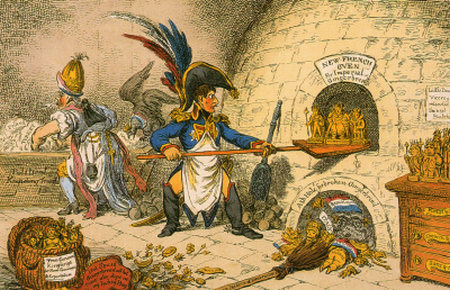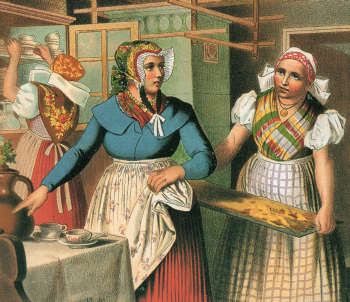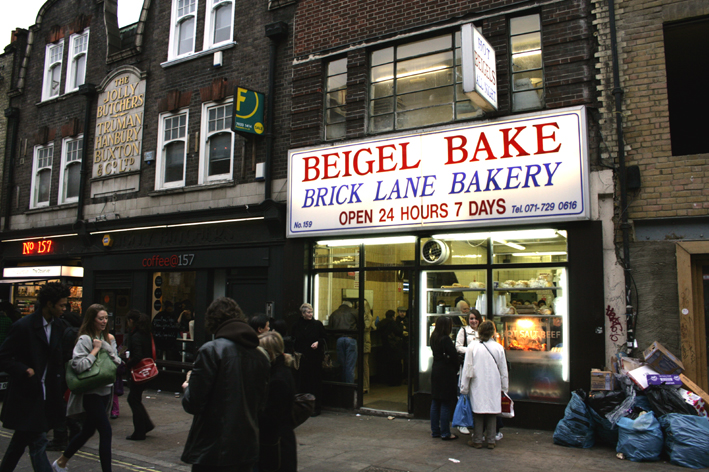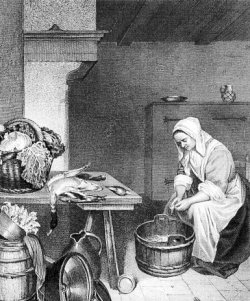A Review of Two Good Books
Spicing Up Britain: The Multicultural History of British Food by Panikos Panayi
The British Housewife: Cookery Books, Cooking and Society in Eighteenth-Century Britain by Gilly Lehmann
It recently has been observed that much historical writing about food is poor. In contrast to a very few serious studies by competent scholars, “there are many less serious ones, whose authors appear hardly to have consulted a cookery book at all, with ludicrously inept results.” The same writer also remarked upon “the increasingly numerous secondary sources of dubious value.” (Lehmann 12,10). In this, food writing shares an intellectual sinkhole with much of academic Marxist history, if for different reasons. Some writers about food are simply amiable slobs, but the Marxists tend to cherish doctrine over objectivity or facts, jargon over lucid prose and vituperation instead of honest debate.
Naturally Marcus Rediker springs to mind. Rediker not only has failed to write a convincing paragraph about anything he ever has addressed, but also has had the ugly temerity to accuse David Brion Davis, liberal lion and author of compassionate histories about the slave issue, of “red baiting” and “grotesque ideological distortion” merely for politely disclosing some of the ridiculous factual errors, and usefully questioning the intellectual rigor, that undermine the conclusions of a typically execrable book co-authored by Rediker. (NYRB) His excruciating prose is another thing altogether; but perhaps we digress.
The, generally, more personable food writers tend to recycle received wisdom rather than conduct competent research, and frequently fail to provide citations to quoted material. Unremarkable assertions tend to be presented as revelatory pronouncements. Their writing is often amateurish if, in contrast to many of the Marxists, inoffensive.
It therefore is a pleasure to review two books that combine rigorous research with careful analysis and good writing. The first, Spicing Up Britain by Panikos Panayi, traces the origins and evolution of foodways practiced by immigrants in Britain from the nineteenth century until the present time. The book actually delivers more than its title indicates, because it opens with a chapter that provides a lively summary tracking the evolution of modern British food as reflected in British cookbooks. This bonus, however, includes the only flaw in the author’s analysis.
Panayi uses ‘British’ in this immediate context both to describe a distinctively British cuisine and the foods of any cuisine prepared by cooks in Britain. According to Panayi, during the postwar decades
“the concept of British food has developed partly as a reaction to the increasing popularity of what we might describe as foreign foods. Before the Second World War the idea of British food, like the concept of foreign dishes, remained relatively undeveloped.” (Panayi 14)
We disagree with this interesting thesis. In our view imperial Britain had such confidence that it borrowed whatever it liked, including foods and recipes, from other countries without concern over any loss of national or cultural identity, although we cannot fail to observe that British knowledge and execution of ‘foreign’ dishes was, lamentably, another matter. British food, and a national perception of its characteristics, never really disappeared despite the fears of some champions including, most notably, Florence White during the 1920's and 30's.
 After claiming that “[f]ew cookbooks before 1950 specifically focused on British food,” Panayi describes a number of them, including works by Louise Nicoll and White herself, and could have cited others. In 1935, for example, Selfridges published English Recipes, Including the Traditional Recipes of Scotland, Ireland and Wales by the prolific if problematic ‘Countess Morphy.’ Earlier, Careme had included predominantly French recipes but differentiated nine British soups from their French counterparts, and back in the eighteenth century Hannah Glasse famously had railed against French technique and influence. Scores of cookbooks that concentrated on explicitly British preparations appeared in print during the century between Glasse and Careme, starting with the influential Elizabeth Raffald in 1769, who disparaged such French standards as cullis, and The London Art of Cookery by ‘John Farley’ in 1783, which cribbed from Mrs. Raffald's book. In 1852, Catherine Dickens, writing as ‘Lady Maria Clutterbuck,’ included nothing but recognizably English menus in What Shall We Have for Dinner? during the international frenzy of the Great Exhibition, and in 1860 ‘Tabitha Tickletooth’ contrasted English from French food in The Dinner Question.
After claiming that “[f]ew cookbooks before 1950 specifically focused on British food,” Panayi describes a number of them, including works by Louise Nicoll and White herself, and could have cited others. In 1935, for example, Selfridges published English Recipes, Including the Traditional Recipes of Scotland, Ireland and Wales by the prolific if problematic ‘Countess Morphy.’ Earlier, Careme had included predominantly French recipes but differentiated nine British soups from their French counterparts, and back in the eighteenth century Hannah Glasse famously had railed against French technique and influence. Scores of cookbooks that concentrated on explicitly British preparations appeared in print during the century between Glasse and Careme, starting with the influential Elizabeth Raffald in 1769, who disparaged such French standards as cullis, and The London Art of Cookery by ‘John Farley’ in 1783, which cribbed from Mrs. Raffald's book. In 1852, Catherine Dickens, writing as ‘Lady Maria Clutterbuck,’ included nothing but recognizably English menus in What Shall We Have for Dinner? during the international frenzy of the Great Exhibition, and in 1860 ‘Tabitha Tickletooth’ contrasted English from French food in The Dinner Question.
It seems that Panayi may have been influenced here by the vogue for seeing questions of ‘identity’ in every field of historical inquiry. Perhaps he ought to have said, or meant to say, that notions of British food remained implicit in the culture if not always explicit in its written expression. Panayi notes that Mrs. Beeton mixed up her recipes and included roughly as many “from India as from Wales, Scotland and Ireland put together” (but reasons other than neglect of British food may provide the explanation) and that Ann Bowman’s The New Cookery Book: A Complete Manual of English and Foreign Cookery from 1867 “does not spend time distinguishing between English and French foods.” (Panayi 14-15) Whether or not Bowman’s text makes that distinction explicit, however, the title alone indicates that it was clear to her.
As to Mrs. Beeton, it was simply logical of her to group recipes by ingredient rather than nationality for ease of reference, much as most contemporary cookbooks are organized. Furthermore,
“Household Management is delicately poised between modernity and nostalgia.... The culinary classics of pre-industrial England rub shoulders with the latest fashionable fripperies and with dishes imported from all over Europe and the Empire.... The book that is generally seen as representative of all that is traditionally British is in fact generously larded with recipes of foreign extraction.” (Humble 18-19)
British people remained conversant with their indigenous ‘classics’ when Mrs. Beeton was published at mid-century; the inclusion of novel recipes reflected their growing confidence and curiosity about the world rather than an absentmindedness about their own food. The fact that British food subsequently became discredited does not mean that it previously had been an ‘undeveloped concept.’
Panayi also observes that “[d]uring the Second World War, the Ministry of Food published hundreds of recipes aimed at making rationing more palatable, but while ‘British’ ones predominated, the Ministry did not have any overt aim to develop a native cuisine.” (Panayi 14-16) That, however, is because the Ministry perceived no need to ‘develop’ one: British recipes predominated because, as had been the case a century ago, that is what most people would cook; even during a time of grave external threat and supercharged nationalism, the British required no prodding to remind them of their robust food tradition.
That recognition distinguishes them from the Irish, or at least Irish immigrants to the British mainland. By the beginning of the First World War hundreds of thousands of them lived and worked in Britain. According to Panayi, however, “[w]hile food played a central role in the consumption patterns of Jews, Germans, Italians and the Chinese, the same did not apply to the Irish for a variety of reasons, particularly the closeness of their diet to British norms.” (Panayi 124) Furthermore, in addressing the elephant in the Irish kitchen, and notwithstanding the proliferation of ‘Irish’ specialty shops and prefabricated theme pubs in postwar Britain (and, he could have added, the United States), Panayi deftly notes that “[t]he consumption of more potatoes than the native British working classes may represent a difference, but hardly an ethnic characteristic.” (Panayi 43) Not to belabor the point, but if an identifiable British cuisine did not exist, the food of the Irish could not resemble one and the cuisines of other immigrants could not be distinguished from it.
In any event, Panayi’s judgment about the Irish in Britain, like his judgments about the other immigrant ethnicities he surveys, is sound. He also is admirably brave in admitting that he lacks the answer to every question. He is unsure, for example, precisely why the Irish alone did not develop an identifiable food culture.
 By 1914, a much smaller number of Germans, some 60,000 of them, had emigrated to Britain. In contrast to the Irish, they initially retained a distinctive culinary identity and maintained German food shops, restaurants and beer halls, not to mention German language newspapers. Yet as Panayi notes, these institutions had disappeared by the end of the Edwardian era, and not because of the onset of war and xenophobia. Instead, in an insightful observation, Panayi explains that the loss of a distinctive German cuisine in Britain was an unanticipated consequence of the immigrants’ success. Germans assimilated so happily into British society, primarily through intermarriage, that they lost a discernable cultural identity across the board.
By 1914, a much smaller number of Germans, some 60,000 of them, had emigrated to Britain. In contrast to the Irish, they initially retained a distinctive culinary identity and maintained German food shops, restaurants and beer halls, not to mention German language newspapers. Yet as Panayi notes, these institutions had disappeared by the end of the Edwardian era, and not because of the onset of war and xenophobia. Instead, in an insightful observation, Panayi explains that the loss of a distinctive German cuisine in Britain was an unanticipated consequence of the immigrants’ success. Germans assimilated so happily into British society, primarily through intermarriage, that they lost a discernable cultural identity across the board.
 Jews, Italians and Chinese were different again, and Panayi is convincing in his discussion of them all. To use one of these groups as an example, Jewish people in Britain, like the Irish, not only stood out due to religious difference from the majority but also tended to concentrate in cohesive and geographically distinct areas. Unlike the Irish, however, British Jews did retain a complex dietary culture and Panayi explains how their contrasting religious practices and notions of identity account for that.
Jews, Italians and Chinese were different again, and Panayi is convincing in his discussion of them all. To use one of these groups as an example, Jewish people in Britain, like the Irish, not only stood out due to religious difference from the majority but also tended to concentrate in cohesive and geographically distinct areas. Unlike the Irish, however, British Jews did retain a complex dietary culture and Panayi explains how their contrasting religious practices and notions of identity account for that.
Panayi himself is of Greek Cypriot stock, and if his anecdotal treatment of that community--his father is a first generation immigrant and a baker--is a little self-indulgent, it also is charming and forgiven. This is an accessible but serious and recommended study of an intriguing subject.
The second book under consideration is by the author of the passages quoted in the introduction to this review. She is Gillian Lehmann and a formidable scholar based on the evidence of The British Housewife: Cookery Books, Cooking and Society in Eighteenth-Century Britain. Once again, the title is misleading because like Panayi, Lehmann delivers more than she promises. She starts by tracing the impact of printed cookbooks on Tudor cooking (French influence as early as the 1500s was an interesting surprise), the consequent rise of court cookery and the beginning of what amounts to modernization toward the end of the sixteenth century (there is a helpful discussion of the different audiences of male and female authors even this early, and of Robert May and Gervaise Markham) before addressing the 1700s in detail.
Lehmann provides so much interesting detail, and writes with such clear precision, that it is possible to pluck random passages from the text and enjoy them without reading the whole, if time is short--but find time to read this book from start to finish. It is more interesting to follow her patterns of thought as she explains the upshot of her thorough research. Her conclusions are convincing and provoke a number of thoughts on Georgian society, and it is no mean feat to create a mirror of the larger culture through a study of its food.
Thus, the manner of dining conferred social station, but the gentry and “middling classes in the expanding cities” betray “no sense of any desire to emulate aristocratic habits.” (Lehmann 374-75, 376) In this their foodways mirrored their growing political and cultural influence, and confidence, and distinguished them from their continental counterparts on all counts.
If Lehmann’s insights are more deft than earthshattering--after all, we have the images of Hogarth, Gillray and lesser lights to reinforce many of them--that in no way diminishes her accomplishment. The implications of what Lehmann has found reinforce the conclusion of Tim Blanning and others that Britain was indeed a place apart, blessed with a relatively broad, porous and fluid political nation (at least by the standards of the eighteenth century) that shared a greater sense of common cause than its European counterparts. The taxpayers who taxed themselves through Parliament, to borrow one of Blanning’s images, all ate much the same food, and they ate it with relish.
England in particular differed in other ways too; professional cooking was a male monopoly elsewhere but foreigners (in this context including Scots) remarked repeatedly at the number of women employed as cooks in the houses of the gentry and ‘middling sort.’

That's why the lady is a chef (part deux)
The influence of women, as authors as well as cooks, eventually would cut both ways. Lehmann notes that books by female authors tended to display a more distinctly English character than books by men, in large measure because their relatively less complex recipes were aimed at a broader, less wealthy (and more female) audience. Examination of the books themselves bears her out. (Lehmann 162-63 and elsewhere) The employment of women also guarded the flame of British cuisine generally; nobody imported female chefs from France.
Thus, if gender set many English cooks apart, so did the food that English cooks produced. Alan Davidson and others have maintained that French and English technique are not fundamentally dissimilar historically, but Lehmann demonstrates that especially as the seventeenth century progressed, English cookbooks and the foodways they expressed diverged from French patterns in style as well as content. At the beginning of the century, the complicated court style of cooking, heavily influenced by French cooks and books, held sway; by the end of the century it had almost disappeared, and for reasons with implications broader than foodways. Cookbooks reached a wider audience than elsewhere, and while, for example, the relatively small number of French publications addressed experienced professionals, the bigger English printing runs and wider range of titles also reached farther down the social and skilled scale.
In discussing one of the recipes that The London Art of Cookery appropriated from Mrs. Raffald, Lehmann explains that:
“The fairly simple dish and its short cooking time are typical, yet its detailed instructions would be deemed superfluous in a French book. The cook is told to use a wooden spoon, and given the reason for the brief cooking, without boiling, once the sauce is made. This is written for the uninitiated.” (Lehmann 255)
Unfortunately, the prevalence in the kitchen of hired women also carried a virus that threatened to ruin British food as the eighteenth century came to a close. Lehmann maintains that:
“....The most important factor in the decline of English cookery, which is only just starting, is the gap between the kitchen and the table, between the people who produced the dishes and the people who consumed them. New models of femininity and gentility conspired to keep the mistress of the household out of the kitchen, and increasing numbers of ladies neglected domestic management for more decorous accomplishments.” (Lehmann 279)
Did things really get that bad this early? Apparently they did: “It is thus hardly surprising to find so much negative comment on English food from foreign travellers.... ” (Lehmann 279) Other factors also must have been in play, but the transformation of British society from the relatively fluid vertical hierarchies of the ‘long eighteenth century (1688-1815)’ to the relatively ossified and horizontal Victorian class structure itself did transform the quality of British food, and not for the better.
Lehmann is particularly refreshing when she examines subjects, like The London Art of Cookery, that have become distorted by a historiographical game of telephone tag in which received wisdom is reiterated and becomes inadvertently mutated by authors who have not independently examined the underlying facts. Numerous writers have described the food and posited the culture of eighteenth century taverns by reference to ‘Farley’s’ London Art and a clutch of other ‘tavern’ cookbooks. These taverns were internationally renowned for their food, and historians have remarked repeatedly on the originality of the books. In Spices, Salt and Aromatics in the English Kitchen, Elizabeth David even fell into the trap by commending ‘Farley’s’ clarity of voice and style. As our use of single quotations around his name infers, however, something is amiss. It turns out that:
“.... These books did not in fact reveal the secrets of what was eaten in London taverns. Though signed by John Farley, Francis Collingwood and John Wollams, and T. Williams and his friends, they were simply compilations by a hack writer.... These productions derive very largely from Glasse and Raffald, to the extent of offering virtually identical recipes. The tavern cooks’ names and roll-call of places where they worked were simply devices to appeal to buyers. These were expected to be women servants.” (Lehmann 148)
The British Housewife includes an appendix of “Some cookery books in detail” that itself is worth the (admittedly expensive) price of the book. The descriptions are detailed and informative but not stuffy (one author is a “bibliographer’s nightmare” but Lehmann untangles the various pseudonyms, titles and editions) and the range of titles is impressive. The book is published by Prospect, so the edition is beautiful, even if the index is surprisingly sparse. Lehmann herself is all the more intimidating for having translated the book into sparkling English from the French of her original.
Sources.
Isabella Beeton, Beeton’s Book of Household Management (London 1861)
Tim Blanning, Pursuit of Glory: Europe 1648-1815 (New York 2007)
Ann Bowman, A New Cookery Book: A Complete Manual of English and Foreign Cookery (London 1867)
Lady Maria Clutterbuck (Catherine Dickens), What Shall We Have For Dinner? (London 1852)
Elizabeth David, Spices, Salt and Aromatics in the English Kitchen (London 1970)
David Brion Davis, Peter Linebaugh and Marcus Rediker, “ ‘The Many-Headed Hydra’: An Exchange,” New York Review of Books (20 September 2001)
John Farley, The London Art of Cookery London (1783)
Hannah Glasse, The Art of Cookery Made Plain and Easy (London 1747)
Nicola Humble, Culinary Pleasures: Cookbooks and the Transformation of British Food (London 2005)
Gilly Lehmann, The British Housewife: Cookery Books, Cooking and Society in Eighteenth-Century Britain (Totnes, Devon 2003)
Countess Morphy, English Recipes, Including the Traditional Recipes of Scotland, Ireland and Wales (London 1935)
Panikos Panayi, Spicing Up Britain: The Multicultural History of British Food (London 2008)
Elizabeth Raffald, The Experienced English House-keeper (Manchester 1769)
Tabitha Tickletooth, The Dinner Question (London 1860)
Florence White, Good Things in England (London 1932)

